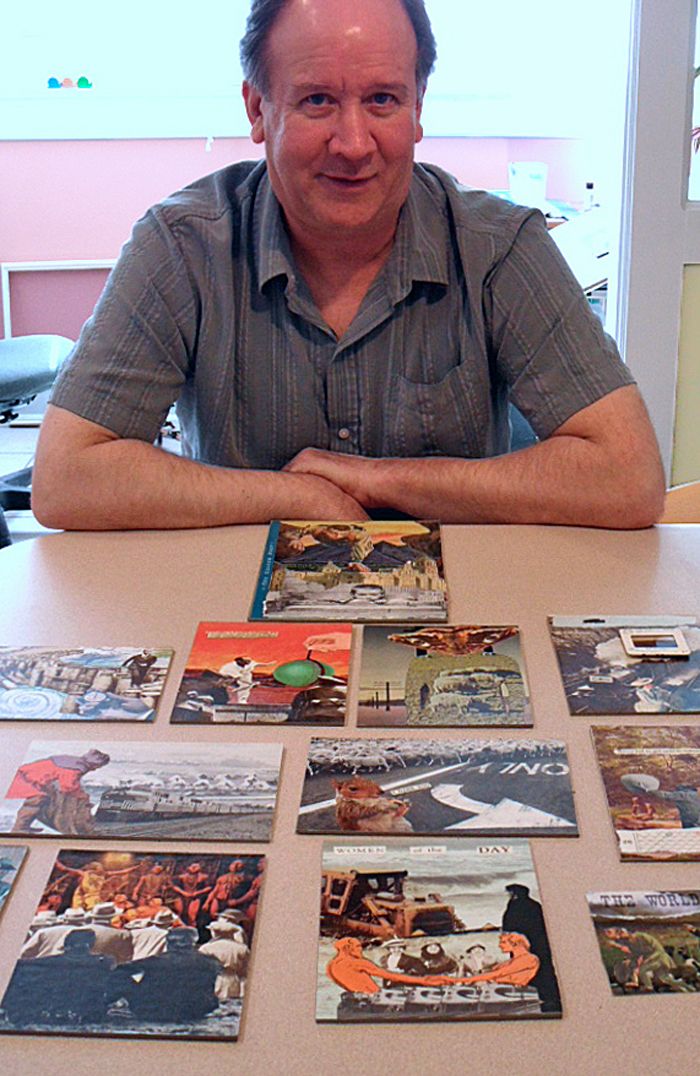As you read this sentence, very likely somewhere in the world a small, hand-crafted postcard is starting to make its way to the small town of North Manchester, Indiana. They have come from as far away as Australia, Serbia and Berkeley, California. One hundred and forty-two are already here, invited by artist Michael Harford and posted on his blog, The World is a Town. Michael Harford is a practitioner of the art form of collage. A lover of vintage books and printed media, he seeks out old volumes and magazines that otherwise would be destined for the trash bin. He then proceeds to rescue some of the vintage images and phrases archived within – little freeze frames of the past century.
“I just flip through and start pulling out things that grab me,” he’s says, claiming that he doesn’t have a reason for his choices, at least not that he’s aware of.
He does reveal, however, that when growing up in San Francisco in the 1960s he began “manifesting pictures in my mind” while listening to radio programs or reading stories. If the child is the father of the man, Harford’s gravitation to collage as a mature adult makes beautiful sense.
A thoughtful individual, sensitive to changes in culture and politics, Harford seems to be piecing together clippings from the past in an ongoing effort to puzzle out the present, how we as a society arrived at the state we’re in.
“As a collage artist, my work addresses my interest in philosophical and political issues through poetic use of postmodern images and concepts,” he writes in his artistic statement. Yet he is careful to leave interpretation up to the viewer, to the point of deliberately leaving his works untitled.
The practice of collage is probably as old as paste, but it has enjoyed periodic heydays. In the 20th century, modernists like Picasso and Braque embraced plastering bits of newspaper and street posters into their paintings. Pop artists had a field day in the 50s and 60s, pouncing upon modern culture’s overabundance of printed matter and stuff in general. Robert Rauschenberg took collage to new, three-dimensional heights in his “Combines” which could feature such startling elements as a full-sized stuffed goat.
Of late, Photoshop has wooed digital artists with its endless possibilities and ease of use to the point where graphic mash-ups are everywhere – magazines, cinema and, of course, the internet.
The digital age seems a curious time to pick up scissors and a glue stick, but therein lies the charm. A recent resurgence and appreciation of handmade items has arrived in backlash against the slick and deceptive digital world.
Harford, when creating his works, tends to keep to a small 5 x 7-inch format. He uses archival backing board and clear gesso as the adhesive/sealant. However, if he runs across a striking hardbound book cover, he will often collage right on its reverse, creating a two-sided work of art.
Although he eschews computers for his creative process, Harford is no digital slouch. An avid blogger, he uses the internet not only to showcase his own work, but to network. Remarkably, in a very short time he has built a worldwide community of artists with his mail art event The World is a Town at www.theworldisatown.blogspot.com.
The theme of The World is a Town is taken from phrases found on an ancient wax palimpsest, the Novgorod Codex, that was unearthed in Russia in 2000. A palimpsest is a booklet, this one with wax-coated pages that could be smoothed out and reused. This particular palimpsest apparently belonged at one point in the 11th century to a disgruntled scribe who vented against the prevailing church on its pages.
“The world is a town in which people worthy of praise are excluded from the church” is just one in a litany of beefs.
In the call for entries, which is still open, artists are invited to create a 5×7-inch work on the theme of exclusion and mail it to Harford in North Manchester. As the pieces arrive, Harford posts them on the blog, and sends the artist one of his own postcards in return. Harford stresses that in the tradition of mail art it is important that there is no exchange of money. The valued goal is simply sharing.
“It keeps everything on an even level,” he explains, “No one better, no one worse.”
When he closes the call for entries, Harford plans to compile all entries into a downloadable PDF file. What he would really like to do, he says, is find an appropriate venue for them to be seen on exhibit.
The project has led to many important connections with artists and publishers and gallery owners, all seeking to work with him in some capacity. A 20-page booklet of his collages has been published by Tonerworks and is available at http://www.reedaltemus.org.
Perhaps the most avant garde deployment of his collages has been their exhibit on an LED highway billboard in Duluth, Minnesota as part of The Billboard Art Project, a movement that puts those big commercial screens to higher purpose in towns across America. Harfords’ collages will again appear in lights later this year.
“I will have 10 collages shown on The Billboard Art Project in Quincy, Illinois September 14-16, 2012. Instead of ads, only art is shown in rotation during this time. They can be seen from the street and the highway.”
Not long afterwards, he will participate in an exhibit at Bodelwyddan Castle in North Wales.
These are exciting times for Harford, who started out as a young art student at the San Francisco Academy of Art but put his artistic aspirations on hold for much of his life as he met the demands of fatherhood and head of household. After this long wait, it is sweet to see that the world is a town that embraces his artwork.

